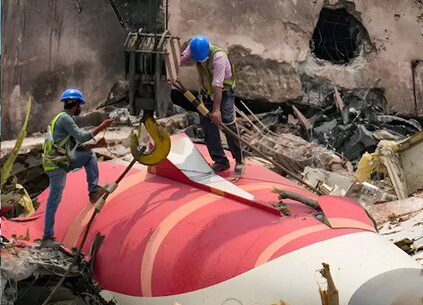In a deeply unsettling revelation, the preliminary investigation into the recent Air India plane crash has identified that both engines of the aircraft lost power merely seconds after takeoff due to the sudden cutoff of fuel supply. The incident, which occurred on June 12, 2025, involved Air India Flight AI 171, a Boeing 787 Dreamliner en route from Ahmedabad to London. The tragedy claimed 260 lives: 241 onboard and 19 on the ground- making it one of the deadliest aviation disasters in Indian history.
According to the Aircraft Accident Investigation Bureau’s (AAIB) preliminary report, the fuel-control switches for both engines were manually moved from the “RUN” to the “CUTOFF” position just three seconds after the aircraft lifted off. This action immediately shut off fuel supply to the engines, resulting in the complete loss of thrust. Despite attempts by the pilots to restart the engines, the aircraft lost altitude rapidly and crashed within 32 seconds of takeoff.
The cockpit voice recorder captured an alarming exchange between the two pilots. One pilot reportedly asked, “Why did you cut off the fuel?” to which the other denied having done so. A mayday call was issued shortly after, as the crew tried to regain control, but it was too late. Investigators have confirmed that the fuel switches cannot be moved accidentally, raising serious questions about the circumstances under which they were activated.
The report has ruled out mechanical failure, sabotage, or bird strike as contributing factors. It confirmed that the aircraft was airworthy, fully fueled, and within operational weight limits. The Dreamliner’s onboard systems, including emergency response mechanisms like the Ram Air Turbine (RAT), activated as expected following the engine failure. Yet, these safety systems were unable to avert the crash due to the rapid sequence of events.
As of now, investigators have not determined why the fuel switches were flipped. Human error, misjudgment, or other undisclosed factors remain under close examination. The AAIB has completed its analysis of the cockpit recordings and flight data recorders, while forensic examination of the engine systems is ongoing.
The lone survivor of the crash is currently recovering and is expected to provide a crucial eyewitness account. The survivor’s testimony may shed light on any last-minute announcements, in-cabin alerts, or anomalies that might help investigators reconstruct the final moments before the crash.
Following the preliminary findings, India’s Civil Aviation Ministry has launched an internal safety review across the Air India Dreamliner fleet and is also conducting audits of other carriers operating similar aircraft. Global aviation bodies have also been notified of the incident, although no immediate technical directive has been issued for Boeing 787 aircraft or the GE engines involved.
The final AAIB report is expected within the next twelve months. It will determine if systemic changes are needed in cockpit safety protocols, pilot training, or aircraft interface design. Until then, the aviation community, both in India and globally, watches closely as one of the most tragic events in recent air travel history continues to unfold.
Also Read: Jaguar Fighter Jet Crash in Rajasthan Kills 2 Pilots Amid Mounting Safety Alarms
